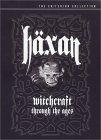| Reviews & Columns |
|
Reviews DVD TV on DVD Blu-ray 4K UHD International DVDs In Theaters Reviews by Studio Video Games Features Collector Series DVDs Easter Egg Database Interviews DVD Talk Radio Feature Articles Columns Anime Talk DVD Savant Horror DVDs The M.O.D. Squad Art House HD Talk Silent DVD
|
DVD Talk Forum |
|
|
| Resources |
|
DVD Price Search Customer Service #'s RCE Info Links |
|
Columns
|
|
|
Häxan
The film is made up of seven titled chapters (i.e. The Trials, Torture, Sinful Thoughts etc) and a series of vignettes that show us historical artwork and staged scenes recreating medieval sorcery and the work of witches and demons.
In the 15th century if women displayed irrational behavior then some people – especially the always fearful clergy – would assume that they were witches. Christensen takes a rational psychological point-of-view that people living in a superstitious period simply reverted to their most frightening thoughts. He concluded that no matter how untenable the rational it was women (by the tens of thousands) who suffered as a consequence.
Even though the film sides on the rational scientific side of the debate it is full of creepy, unsettling (and admittedly humorous) imagery and wildly imaginative recreations of evil acts, possessions and spells done by witches, demons and evil spirits. Christensen himself plays the Devil in two of the films more bizarre scenes: Chapter 8 where the Devil temps a woman and Chapter 17 where he temps a nun. According to the commentary track, so unsettling was Häxan at the time of it's initial release that one young man after seeing the film felt that he had become possessed and was found the next day wandering the streets in a daze.
From another historical perspective the film had a definite influence on the surrealist who came along just a few years later.
Video:
Häxan is presented in 1.33:1 aspect ratio and impressively displays the sepia, red and blue color tinting tones that were used in the silent film era. The film has been restored by the Swedish Film Institute from the original camera negative and has new intertitles. According to the notes on the inside jacket - in order to present the film in its proper speed - the transfer of the film was done at 20 rather than 24 frames per second. Due to the film's age the print has a fair number of scratches and sign of age but it still looks as good as any silent film currently available on DVD. Compression artifact is visible on some of the images but not enough to warrant a complaint.
Audio:
The film's score is presented in 2.0 and Dolby 5.0 surround sound. This later is particularly suitable to the wonderful musical score, which consists of many of the classical works of Beethoven, Bach, Hayden and Gluck and has been arranged by Gillian Anderson and performed by the Czech Film Ochestra. The 11-piece orchestra sounds great and best of all the performance helps us realize how great silent film can be when it is presented properly - that is to say with a score.
Extras:
The best extra is the Commentary track by Casper Tybjerg an enlightening, anecdotal, historical commentary that adds much to the film. Tybjerg is a Danish film scholar who speaks with an interesting accent and is clearly reading from a text but his stories really draw you in. And, since Häxan is a silent film, you can watch and listen at the same time without losing any of the film's visual meaning. There is also a worthy eight minute Introduction by Benjamin Christensen from the 1940's that adds a little backstory to the film and four minutes of Rare Outakes, one of which has Christensen doing a test run for a flying witches scene; he sits in a chair and superimposed over him is an image taken from a moving train. Other extras include a photographic exploration of Christensen's historical sources called Bibliotheque Diabolique and a Stills gallery that included over 40 images of the production. Not listed on the box is a Musical Score menu that has a list of all of the musical pieces in the film. The main menu has 21 chapters and color bars.
Also included as an extra is Witchcraft Through the Ages a shorter cut of the film put together in 1968 and narrated by William S. Burroughs. This is really more than an extra. It's just another version of the film and most likely more people have seen this version than have seen Häxan since Burroughs is a literary cult figure. The version doesn't have the same color tinting – it is all black and white but it features a cool jazz score that features John-luc Ponty and since it is almost 30 minutes shorter it is edited quicker. I saw no menu for this version but there are 16 chapters. The inside jacket includes an excellent essay by Chris Fujiwara and film score notes by Gillian Anderson.
Overall:
Häxan probably won't scare many viewers today but its trippy, medieval, evil imagery and imaginative rendering of olde time sorcery along with its informative history is enough to bewitch any viewer with an open mind and a little time on their hands. And with the top notch work done on the sound, the images and the extras by Criterion the DVD is worth checking out.
|
| Popular Reviews |
| Sponsored Links |
|
|
| Sponsored Links |
|
|
| Release List | Reviews | Shop | Newsletter | Forum | DVD Giveaways | Blu-Ray | Advertise |
|
Copyright 2024 DVDTalk.com All Rights Reserved. Legal Info, Privacy Policy, Terms of Use,
Manage Preferences,
Your Privacy Choices | |||||||













